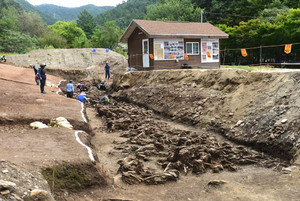This article is originally in Korean. These are some excerpts with machine translation and my slight additions:
Jeju Special Self-Governing Province and the Jeju April 3rd Peace Foundation announced that the identity of the missing April 3rd victim, whose fate was unknown, was confirmed in Golnyeonggol, Daejeon [Note: Several photos of violence and human remains are in that link], after 74 years.
The victims identified this time are 70 of the 1,441 remains excavated in Golnyeonggol through the first pilot project of ‘Genetic identification of 4/3 victims from excavated remains from outside the province’ conducted by Jeju Special Self-Governing Province and the Jeju 4/3 Peace Foundation.
The person whose identity was confirmed was the late Kim Han-hong, from Bukchon-ri, Jocheon-myeon, Jeju-si. During the April 3 Incident, he was hiding in a field away from the village to avoid punitive forces and armed forces. He came to the military at the end of January 1949 and surrendered himself on the rumor that he would be set free if he surrendered. The bereaved family said that after being detained in the distillery camp, no news was heard.
The list of prisoners shows that the victim was sentenced to seven years in prison on July 4, 1949 and served his sentence at Daejeon Prison.
On October 4, the remains of the victims went through a handover process with the bereaved families, the Jeju April 3 Victims’ Families Association, the Sanae Incident Victims’ Families Association, and officials from the Ministry of the Interior and Safety in attendance, and a ritual was held at Sejong Eunhasu Park under the auspices of the bereaved families, and then cremated in October. They are scheduled to be repatriated to Jeju by plane on the 5th.
At the site where the remains of the victims are returned to their hometown, the bereaved families and officials, including Governor Oh Young-hoon, will greet them in person, and a ceremony to return the remains will be held afterwards. Subsequently, an identification briefing session will be held on the same day to commemorate the victims and comfort their bereaved families.
The Truth and Reconciliation Commission is in the process of collecting remains from 2,000 of the 3,900 remains temporarily enshrined in the Sejong Memorial House, including the remains of the Daejeon Golryeonggol victims, and is conducting genetic tests on bereaved families. is planned to be carried out.
Chairman [of the Daejeon Mountain Incident Victims’ Families Associatio] Jeon Mi-kyung said, “How good would it have been if something like this had happened to the families of the massacred people while they were still alive?” and “It breaks my heart that many family members of the massacred people are still passing away while the genetic identification is delayed.”
The son of the late Kim Han-hong, whose identity was recently confirmed through genetic identification, died in 2020 without being able to identify his father’s remains. However, fortunately, he was able to confirm his identity because he left behind DNA data through blood collection while he was still alive.___


